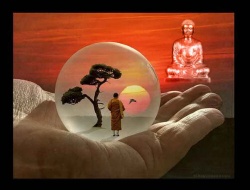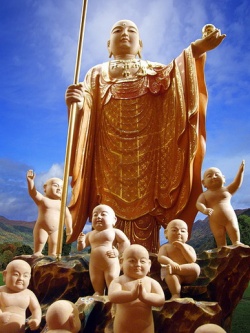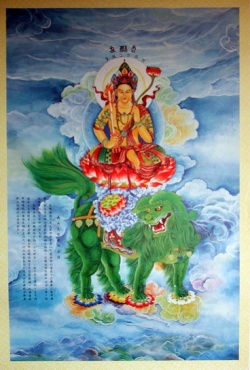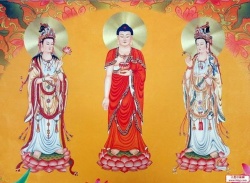Buddhism As A Science Of Mind
Excerpted from a transcript on the "Khe-juk Teachings" (Nova Scotia 1992)
The buddhadharma, the teachings of Lord Buddha Shakyamuni, is a path that frees one from disturbing emotions and fundamental ignorance. This dharma frees us from existence in samsara,
defined by samsaric fear, and leads us towards the fruition of independence, the fruition of the state of complete freedom, the state of fearlessness, going beyond fear.
If we look at this buddhadharma, or Buddhism, closely, we find that it is a pure path, pure teachings, a pure science, a science of mind.
We can say that Buddhadharma is not a religion.
It's a science, a pure and genuine philosophy of humanity and science which works with the two sides of our samsaric mind, the negative aspect and the positive aspect of our mind.
Fundamentally it is the science of working with the very basic nature of our mind.
"Nangpa" - Insider
Therefore it is interesting to look at the Tibetan term for Buddhism. What we call Buddhism in Tibetan is nang pa, which means insiders.
It's an interesting term, insiders; it can have two meanings.
Literally, it means someone who is within a certain boundary, within a certain fence but another meaning of this word insider is the sense that we are working with our inside, our mind, our fundamental confusion, ignorance.
Therefore we can see what Buddhism is fundamentally, from this term, insider; it is a science, working with our mind, a philosophy of humanity, a human science.
Is Buddhism A Religion?
Thus buddhadharma is not a religion in the everyday connotation of the word. I'm not talking about the sophisticated ways of explaining religion used by university Departments of Religion.
But our regular mundane understanding of religion is somewhat simple: it's a belief, a dogma that we have about some superhuman beings outside our self, some supernatural energy outside one's being which has power, control, over our universe and over sentient beings.
This mundane understanding of religion is a theistic view.
And for that matter, in this usual meaning of religion, that particular external being or external energy is holding our computer keyboard and is doing the programming for us; we don't have any power, we don't have any energy, we don't have any choice. We ourselves have to work with it; we have to wait and see what comes up on the screen.
Holding The Keyboard To Enlightenment In Buddhism, however, we are holding the keyboard; we ourselves are the programmer.
We program our software and we press the command keys on our keyboard.
So depending on our own skill, our own energy and our own knowledge, we get what we want on the screen.
The reason why Buddha taught the dharma is to teach us the command keys.
The Tripitaka is the manual, teaching us how to program, how to use the right command keys, and depending on this knowledge, we can have a successful progression of programs.
Therefore there is no external energy or external being holding our keyboards in Buddhism;
even Buddha himself does not hold our keyboard. Buddha is a teacher, a human being with great knowledge, great wisdom, who can teach us the right keyboard, who can teach us how to work with it,
who has the great compassion to share his knowledge, the great compassion to hand over the keyboard to us.
Even though he has all this knowledge, he does not guard the copyright, saying: "Nobody can use it except me". So we can see his great compassion, his great knowledge, which he shares with us, giving us the keyboard, giving us the knowledge, giving us everything.
This path of buddhadharma is totally free from any theistic view and is totally free from any shape or color. It's like pure water; it has no shape, it has no color.
Depending on the container that we pour the water into, the water adopts that particular shape.
If you want to freeze this pure water, you can do it by putting the water into the freezer, but as soon as you take the ice out of the freezer, it will return to its natural state of pure water having no shape and no color.



